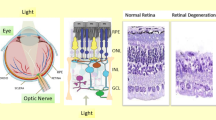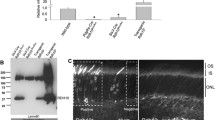Abstract
The vertebrate retina contains typical photoreceptor (PR) cones and rods responsible for day/night vision, respectively, and intrinsically photosensitive retinal ganglion cells (ipRGCs) involved in the regulation of non-image-forming tasks. Rhodopsin/cone opsin photopigments in visual PRs or melanopsin (Opn4) in ipRGCs utilizes retinaldehyde as a chromophore. The retinoid regeneration process denominated as “visual cycle” involves the retinal pigment epithelium (RPE) or Müller glial cells. Opn4, on the contrary, has been characterized as a bi/tristable photopigment, in which a photon of one wavelength isomerizes 11-cis to all-trans retinal (Ral), with a second photon re-isomerizing it back. However, it is unknown how the chromophore is further metabolized in the inner retina. Nor is it yet clear whether an alternative secondary cycle occurs involving players such as the retinal G-protein-coupled receptor (RGR), a putative photoisomerase of unidentified inner retinal activity. Here, we investigated the role of RGR in retinoid photoisomerization in Opn4x (Xenopus ortholog) (+) RGC primary cultures free of RPE and other cells from chicken embryonic retinas. Opn4x (+) RGCs display significant photic responses by calcium fluorescent imaging and photoisomerize exogenous all-trans to 11-cis Ral and other retinoids. RGR was found to be expressed in developing retina and in primary cultures; when its expression was knocked down, the levels of 11-cis, all-trans Ral, and all-trans retinol in cultures exposed to light were significantly higher and those in all-trans retinyl esters lower than in dark controls. The results support a novel role for RGR in ipRGCs to modulate retinaldehyde levels in light, keeping the balance of inner retinal retinoid pools.





Similar content being viewed by others
References
Berson DM, Dunn FA, Takao M (2002) Phototransduction by retinal ganglion cells that set the circadian clock. Science 295(5557):1070–1073. doi:10.1126/science.1067262
Hattar S, Liao HW, Takao M, Berson DM, Yau KW (2002) Melanopsin-containing retinal ganglion cells: architecture, projections, and intrinsic photosensitivity. Science 295(5557):1065–1070. doi:10.1126/science.1069609
Provencio I, Rodriguez IR, Jiang G, Hayes WP, Moreira EF, Rollag MD (2000) A novel human opsin in the inner retina. J Neurosci: Off J Soc Neurosci 20(2):600–605
Panda S, Sato TK, Castrucci AM, Rollag MD, DeGrip WJ, Hogenesch JB, Provencio I, Kay SA (2002) Melanopsin (Opn4) requirement for normal light-induced circadian phase shifting. Science 298(5601):2213–2216. doi:10.1126/science.1076848
Panda S, Provencio I, Tu DC, Pires SS, Rollag MD, Castrucci AM, Pletcher MT, Sato TK et al (2003) Melanopsin is required for non-image-forming photic responses in blind mice. Science 301(5632):525–527. doi:10.1126/science.1086179
Lucas RJ, Hattar S, Takao M, Berson DM, Foster RG, Yau KW (2003) Diminished pupillary light reflex at high irradiances in melanopsin-knockout mice. Science 299(5604):245–247. doi:10.1126/science.1077293
Schmidt TM, Alam NM, Chen S, Kofuji P, Li W, Prusky GT, Hattar S (2014) A role for melanopsin in alpha retinal ganglion cells and contrast detection. Neuron 82(4):781–788. doi:10.1016/j.neuron.2014.03.022
Allen AE, Storchi R, Martial FP, Petersen RS, Montemurro MA, Brown TM, Lucas RJ (2014) Melanopsin-driven light adaptation in mouse vision. Curr Biol: CB 24(21):2481–2490. doi:10.1016/j.cub.2014.09.015
Guido ME, Garbarino-Pico E, Contin MA, Valdez DJ, Nieto PS, Verra DM, Acosta-Rodriguez VA, de Zavalia N et al (2010) Inner retinal circadian clocks and non-visual photoreceptors: novel players in the circadian system. Prog Neurobiol 92(4):484–504. doi:10.1016/j.pneurobio.2010.08.005
Wald G (1968) The molecular basis of visual excitation. Nature 219(5156):800–807
Mata NL, Radu RA, Clemmons RC, Travis GH (2002) Isomerization and oxidation of vitamin a in cone-dominant retinas: a novel pathway for visual-pigment regeneration in daylight. Neuron 36(1):69–80
Diaz NM, Morera LP, Guido ME (2016) Melanopsin and the non-visual photochemistry in the inner retina of vertebrates. Photochem Photobiol 92:29–44. doi:10.1111/php.12545
Matsuyama T, Yamashita T, Imamoto Y, Shichida Y (2012) Photochemical properties of mammalian melanopsin. Biochemistry 51(27):5454–5462. doi:10.1021/bi3004999
Emanuel AJ, Do MT (2015) Melanopsin tristability for sustained and broadband phototransduction. Neuron 85(5):1043–1055. doi:10.1016/j.neuron.2015.02.011
Qiu X, Kumbalasiri T, Carlson SM, Wong KY, Krishna V, Provencio I, Berson DM (2005) Induction of photosensitivity by heterologous expression of melanopsin. Nature 433(7027):745–749. doi:10.1038/nature03345
Melyan Z, Tarttelin EE, Bellingham J, Lucas RJ, Hankins MW (2005) Addition of human melanopsin renders mammalian cells photoresponsive. Nature 433(7027):741–745. doi:10.1038/nature03344
Panda S, Nayak SK, Campo B, Walker JR, Hogenesch JB, Jegla T (2005) Illumination of the melanopsin signaling pathway. Science 307(5709):600–604. doi:10.1126/science.1105121
Tu DC, Zhang D, Demas J, Slutsky EB, Provencio I, Holy TE, Van Gelder RN (2005) Physiologic diversity and development of intrinsically photosensitive retinal ganglion cells. Neuron 48(6):987–999. doi:10.1016/j.neuron.2005.09.031
Koyanagi M, Kubokawa K, Tsukamoto H, Shichida Y, Terakita A (2005) Cephalochordate melanopsin: evolutionary linkage between invertebrate visual cells and vertebrate photosensitive retinal ganglion cells. Curr Biol: CB 15(11):1065–1069. doi:10.1016/j.cub.2005.04.063
Wang X, Wang T, Jiao Y, von Lintig J, Montell C (2010) Requirement for an enzymatic visual cycle in Drosophila. Curr Biol: CB 20(2):93–102. doi:10.1016/j.cub.2009.12.022
Wang X, Wang T, Ni JD, von Lintig J, Montell C (2012) The Drosophila visual cycle and de novo chromophore synthesis depends on rdhB. J Neurosci: Off J Soc Neurosci 32(10):3485–3491. doi:10.1523/JNEUROSCI.5350-11.2012
Pandey S, Blanks JC, Spee C, Jiang M, Fong HK (1994) Cytoplasmic retinal localization of an evolutionary homolog of the visual pigments. Exp Eye Res 58(5):605–613. doi:10.1006/exer.1994.1055
Hao W, Fong HK (1996) Blue and ultraviolet light-absorbing opsin from the retinal pigment epithelium. Biochemistry 35(20):6251–6256. doi:10.1021/bi952420k
Shen D, Jiang M, Hao W, Tao L, Salazar M, Fong HK (1994) A human opsin-related gene that encodes a retinaldehyde-binding protein. Biochemistry 33(44):13117–13125
Hao W, Fong HK (1999) The endogenous chromophore of retinal G protein-coupled receptor opsin from the pigment epithelium. J Biol Chem 274(10):6085–6090
Chen P, Hao W, Rife L, Wang XP, Shen D, Chen J, Ogden T, Van Boemel GB et al (2001) A photic visual cycle of rhodopsin regeneration is dependent on Rgr. Nat Genet 28(3):256–260. doi:10.1038/90089
Chen P, Lee TD, Fong HK (2001) Interaction of 11-cis-retinol dehydrogenase with the chromophore of retinal G protein-coupled receptor opsin. J Biol Chem 276(24):21098–21104. doi:10.1074/jbc.M010441200
Maeda T, Van Hooser JP, Driessen CA, Filipek S, Janssen JJ, Palczewski K (2003) Evaluation of the role of the retinal G protein-coupled receptor (RGR) in the vertebrate retina in vivo. J Neurochem 85(4):944–956
Wenzel A, Oberhauser V, Pugh EN Jr, Lamb TD, Grimm C, Samardzija M, Fahl E, Seeliger MW et al (2005) The retinal G protein-coupled receptor (RGR) enhances isomerohydrolase activity independent of light. J Biol Chem 280(33):29874–29884. doi:10.1074/jbc.M503603200
Radu RA, Hu J, Peng J, Bok D, Mata NL, Travis GH (2008) Retinal pigment epithelium–retinal G protein receptor-opsin mediates light-dependent translocation of all-trans-retinyl esters for synthesis of visual chromophore in retinal pigment epithelial cells. J Biol Chem 283(28):19730–19738. doi:10.1074/jbc.M801288200
Verra DM, Contin MA, Hicks D, Guido ME (2011) Early onset and differential temporospatial expression of melanopsin isoforms in the developing chicken retina. Invest Ophthalmol Vis Sci 52(8):5111–5120. doi:10.1167/iovs.11-75301
Diaz NM, Morera LP, Verra DM, Contin MA, Guido ME (2014) Early appearance of nonvisual and circadian markers in the developing inner retinal cells of chicken. BioMed Res Int 2014:646847. doi:10.1155/2014/646847
Morera LP, Diaz NM, Guido ME (2012) A novel method to prepare highly enriched primary cultures of chicken retinal horizontal cells. Exp Eye Res 101:44–48. doi:10.1016/j.exer.2012.05.010
Contin MA, Verra DM, Salvador G, Ilincheta M, Giusto NM, Guido ME (2010) Light activation of the phosphoinositide cycle in intrinsically photosensitive chicken retinal ganglion cells. Invest Ophthalmol Vis Sci 51(11):5491–5498. doi:10.1167/iovs.10-5643
Contin MA, Verra DM, Guido ME (2006) An invertebrate-like phototransduction cascade mediates light detection in the chicken retinal ganglion cells. FASEB J: Off Publ Fed Am Soc Exp Biol 20(14):2648–2650. doi:10.1096/fj.06-6133fje
Groenendijk GW, De Grip WJ, Daemen FJ (1980) Quantitative determination of retinals with complete retention of their geometric configuration. Biochim Biophys Acta 617(3):430–438
Garwin GG, Saari JC (2000) High-performance liquid chromatography analysis of visual cycle retinoids. Methods Enzymol 316:313–324
Lin MY, Kochounian H, Moore RE, Lee TD, Rao N, Fong HK (2007) Deposition of exon-skipping splice isoform of human retinal G protein-coupled receptor from retinal pigment epithelium into Bruch’s membrane. Mol Vis 13:1203–1214
Lhor M, Salesse C (2014) Retinol dehydrogenases: membrane-bound enzymes for the visual function. Biochem Cell Biol = Biochim Biol Cell 92(6):510–523. doi:10.1139/bcb-2014-0082
Batten ML, Imanishi Y, Maeda T, Tu DC, Moise AR, Bronson D, Possin D, Van Gelder RN et al (2004) Lecithin-retinol acyltransferase is essential for accumulation of all-trans-retinyl esters in the eye and in the liver. J Biol Chem 279(11):10422–10432. doi:10.1074/jbc.M312410200
Kiser PD, Golczak M, Palczewski K (2014) Chemistry of the retinoid (visual) cycle. Chem Rev 114(1):194–232. doi:10.1021/cr400107q
Kaylor JJ, Yuan Q, Cook J, Sarfare S, Makshanoff J, Miu A, Kim A, Kim P et al (2013) Identification of DES1 as a vitamin A isomerase in Müller glial cells of the retina. Nat Chem Biol 9(1):30–36. doi:10.1038/nchembio.1114
Kaylor J, Alfaro M, Ishwar A, Sailey C, Sawyer J, Zarate YA (2014) Molecular and cytogenetic evaluation of a patient with ring chromosome 13 and discordant results. Cytogenet Genome Res 144(2):104–108. doi:10.1159/000368649
Kaylor JJ, Radu RA, Bischoff N, Makshanoff J, Hu J, Lloyd M, Eddington S, Bianconi T et al (2015) Diacylglycerol O-acyltransferase type-1 synthesizes retinyl esters in the retina and retinal pigment epithelium. PLoS One 10(5):e0125921. doi:10.1371/journal.pone.0125921
Acknowledgments
This work has been supported by the Agencia Nacional de Promoción Científica y Técnica (FONCyT, PICT 2010 No. 647 and PICT 2013 No. 021), Consejo Nacional de Investigaciones Científicas y Tecnológicas de la República Argentina (CONICET; PIP 2011 and 2014), and Secretaría de Ciencia y Tecnología de la Universidad Nacional de Córdoba (SeCyT-UNC). The authors are grateful to Dr. Andrew Tsin and Mrs. Brandy Betts for their excellent assistance in retinoid purification and identification in control retinal samples, and for the gift of the RGR antibody.
Author information
Authors and Affiliations
Corresponding author
Rights and permissions
About this article
Cite this article
Díaz, N.M., Morera, L.P., Tempesti, T. et al. The Visual Cycle in the Inner Retina of Chicken and the Involvement of Retinal G-Protein-Coupled Receptor (RGR). Mol Neurobiol 54, 2507–2517 (2017). https://doi.org/10.1007/s12035-016-9830-5
Received:
Accepted:
Published:
Issue Date:
DOI: https://doi.org/10.1007/s12035-016-9830-5




